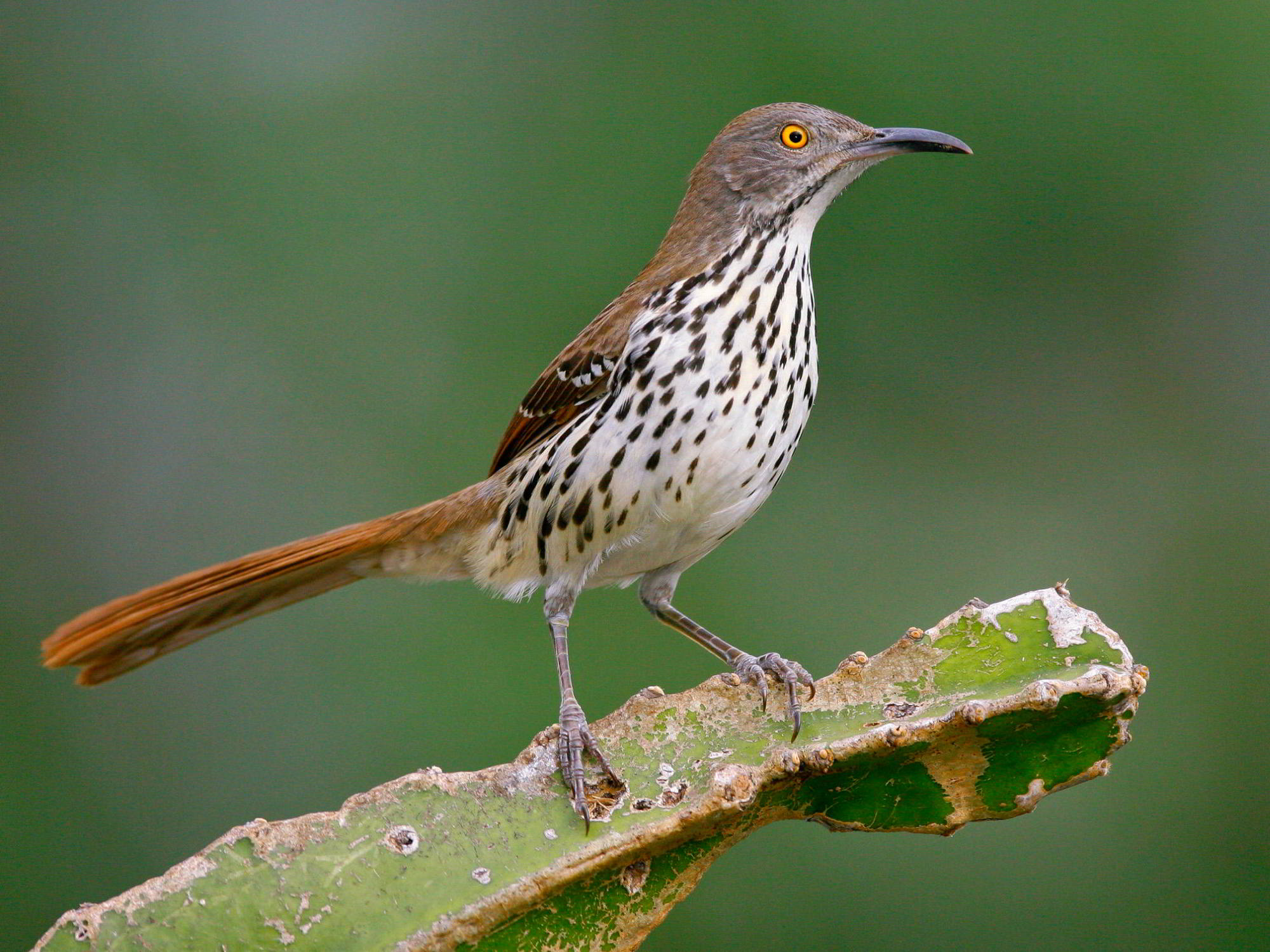It can be a challenging task to identify brown avian species or “LBJs” (Little Brown Jobs) due to the subtle nature of their physical characteristics compared to their more flamboyantly colored relatives.
However, there’s no cause for worry! This practical guide aims to assist you in identifying a range of brown birds, like sparrows and wrens, which are commonly seen around. Additionally, it provides information about the brown birds you can expect to see in Georgia during various times of the year.
With this guide, you’ll be equipped to identify the brown avians that visit your gardens or are sighted in the forested areas and fields. The birds are sorted based on their frequency of sightings, derived from checklists shared by birdwatching enthusiasts in Georgia via eBird.
Seasonal Distribution of Brown Birds in Georgia Year-round Brown Birds in Georgia: The Northern Cardinal, Carolina Wren, Mourning Dove, Eastern Towhee, House Finch, American Robin, Eastern Phoebe, American Goldfinch, Chipping Sparrow, Brown Thrasher, Song Sparrow, Northern Flicker, Brown-headed Cowbird, House Sparrow, and Field Sparrow.
Brown Birds in Georgia during the summer: The Great Crested Flycatcher, Common Yellowthroat, Cedar Waxwing, Wood Thrush, and Louisiana Waterthrush.
Winter Brown Birds in Georgia: The White-throated Sparrow, Hermit Thrush, Pine Siskin, Swamp Sparrow, Savannah Sparrow, Purple Finch, Winter Wren, Brown Creeper, and White-crowned Sparrow.
Migratory Brown Birds in Georgia: The House Wren, Rose-breasted Grosbeak, Swainson’s Thrush, Marsh Wren, and Northern Waterthrush.
Rare or occasional species in Georgia: The American Tree Sparrow, Spotted Towhee, and Bewick’s Wren.
37 Brown Birds In Georgia
1. Northern Cardinal – Female
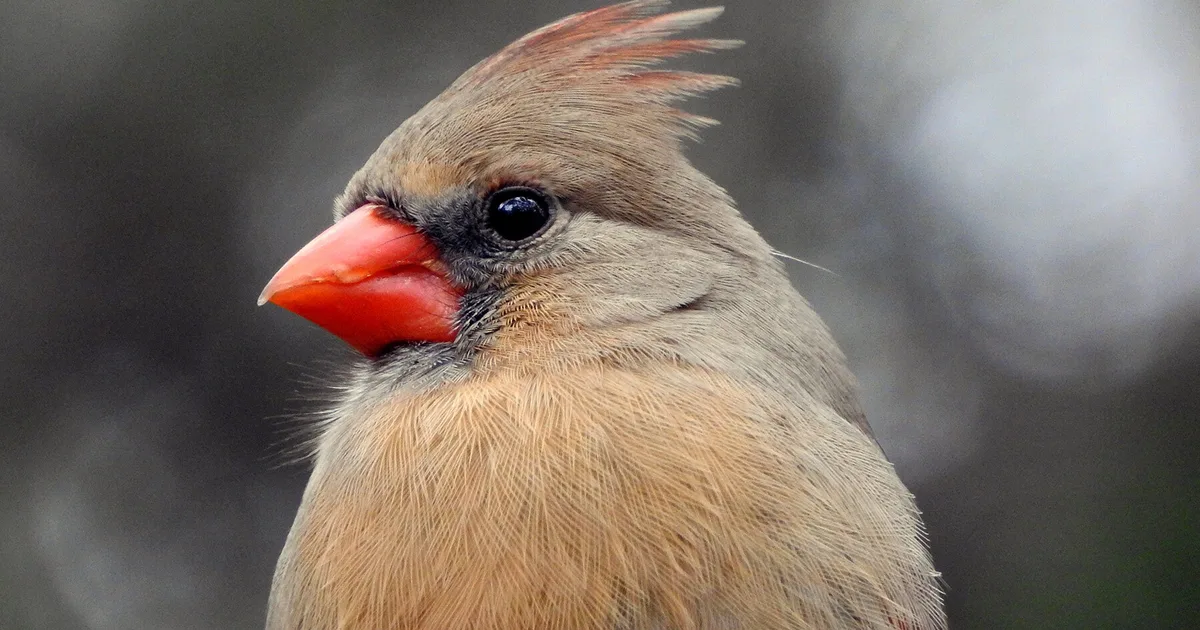
The Northern Cardinal is a prominent bird species in Georgia, residing in the state throughout the year. The birdwatching community records their presence in about 68% of the summer checklists and 59% of winter checklists.
The female Northern Cardinals, although understated in their brown hue, make quite an impression with their distinctive brown crest, striking red highlights, and vivid red beaks.
On the other hand, the male Northern Cardinals, with their dazzling red plumage, a touch of black surrounding their faces, along with their red crests and beaks, are a remarkable sight. They look especially stunning contrasted against a snowy winter landscape.
Scientific name: Cardinalis cardinalis Measurements: Length ranges from 8.3-9.1 inches (21-23 cm), weight varies from 1.5-1.7 ounces (42-48 g), and wingspan spans from 9.8-12.2 inches (25-31 cm). Habitat: Northern Cardinals inhabit the eastern half of the US, extending to some southern states and reaching as far west as Arizona.
These birds are typically found amid thick vegetation where they forage for seeds, fruits, and insects. Interestingly, during the breeding season, Northern Cardinals sometimes exhibit aggressive behavior towards their own reflections as they fiercely safeguard their territories.
You can attract Northern Cardinals to your backyard by setting up feeders filled with sunflower seeds, peanut hearts, millet,
and milo. They are not picky about the type of feeder and will happily eat from large tube feeders, hoppers, platform feeders, or even food strewn on the ground.
2. Carolina Wren
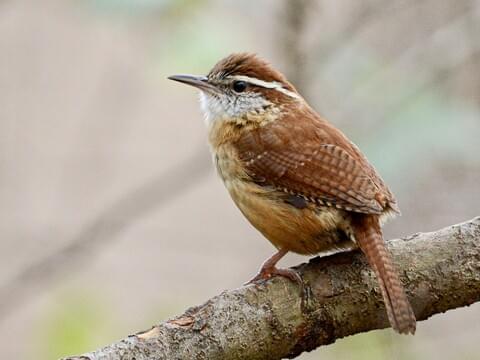
Carolina Wrens, a non-migratory species, are commonly sighted in Georgia. They feature in 54% of summer birdwatching checklists and 48% of winter ones.
These birds are somewhat reserved by nature. They sport a dark brown color on their upper body, contrasting with their light brown undersides. Notable features include a white stripe above their eyes, a tail that stands erect, and a distinctive ‘teakettle’ call that reverberates through the air.
Scientific name: Thryothorus ludovicianus Size: Length varies between 4.7-5.5 inches (12-14 cm), weight ranges from 0.6-0.8 ounces (18-22 g), and the wingspan reaches around 11.4 inches (29 cm).
Throughout the year, Carolina Wrens can be found residing across the eastern and southeastern regions of the United States. Their preferred habitats are woodlands or regions with dense vegetation, though they are not strangers to backyard feeders.
Luring Carolina Wrens to your backyard can be accomplished by setting up feeders filled with suet, hulled sunflower seeds, or peanut hearts. They will feed from large tube feeders or platform feeders.
While many Wrens in Georgia are easily observed in backyards, spotting certain types might require a venture into marshy areas.
3. Mourning Dove

The Mourning Dove is a widely observed bird in Georgia, making its presence known throughout the year. They are documented in 48% of summer bird-watching records and 39% of winter records for the state.
Mourning Doves are elegant creatures, characterized by their small heads, robust bodies, and elongated tails. They don a soft brown plumage, punctuated by black spots on their wings. Males are typically a bit heftier than females.
Scientific name: Zenaida macroura Size: Their length spans from 9.1-13.4 inches (23-34 cm), they weigh between 3.0-6.0 ounces (96-170 g), and their wingspan stretches to 17.7 inches (45 cm).
Mourning Doves are ubiquitous throughout the lower 48 states throughout the year. However, following the breeding season, those residing in the northern Midwest and southern Canada may migrate.
These birds can often be seen perched on telephone lines or foraging for seeds on the ground in grasslands, fields, and residential backyards. They also inhabit open areas or the fringes of woodlands.
To entice Mourning Doves into your backyard, you can scatter millet on the ground or on platform feeders. They are also fond of black sunflower seeds, nyjer, cracked corn, and peanut hearts.
4. Eastern Towhee

Eastern Towhees, a species seen year-round in Georgia, are noted in 40% of summer birding records and 29% of winter checklists submitted by the state’s bird enthusiasts.
These impressive sparrows, roughly the size of a Robin, are marked by their black head, throat, and back, complemented by reddish flanks, long tails, and a white belly in males. The female Eastern Towhees sport a similar pattern but with brown hues replacing the black.
Scientific name: Pipilo erythrophthalmus Size: They measure between 6.8-8.2 inches (17.3-20.8 cm) in length, weigh from 1.1-1.8 ounces (32-52 g), and have a wingspan of 7.9-11.0 inches (20-28 cm).
Eastern Towhees remain throughout the year in the southeastern states of the US, while those in more northern regions migrate south during the winter.
These birds are often found rustling through underbrush and along the peripheries of forests and thickets.
Eastern Towhees typically build their nests on the ground, camouflaged within fallen leaves. These nests, composed of twigs, bark, and leaves and lined with soft grass and animal hair, house up to six eggs. These eggs take just shy of two weeks to hatch, and the fledglings take a similar amount of time to leave the nest.
You can attract Eastern Towhees to your backyard by maintaining overgrown borders and setting up platform feeders filled with black oil sunflower seeds, hulled sunflower seeds, cracked corn, and millet.
5. House Finch – Female
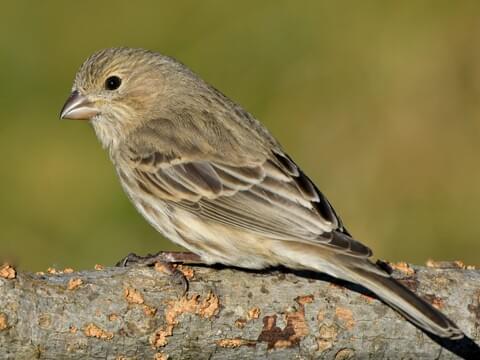
House Finches are year-round inhabitants of Georgia. They are non-migratory birds and are mentioned in 30% of both summer and winter birdwatching checklists for the state.
Female House Finches are adorned with streaks of brown all over their bodies, whereas the males display a vibrant red head and chest, with the remainder of their bodies featuring primarily brown streaks.
Scientific name: Haemorhous mexicanus Size: They measure 5.1-5.5 inches (13-14 cm) in length, weigh between 0.6-0.9 ounces (16-27 g), and their wingspan extends 7.9-9.8 inches (20-25 cm).
Originally found only in the western states of the US, House Finches were introduced to the eastern states, where they have thrived, even managing to outcompete the Purple Finch.
House Finches are typically seen in parks, farms, edges of forests, and backyard feeders, where their lively gatherings are hard to overlook.
You can attract House Finches to your backyard feeders by providing black oil sunflower seeds or nyjer seeds in tube or platform feeders.
6. American Robin
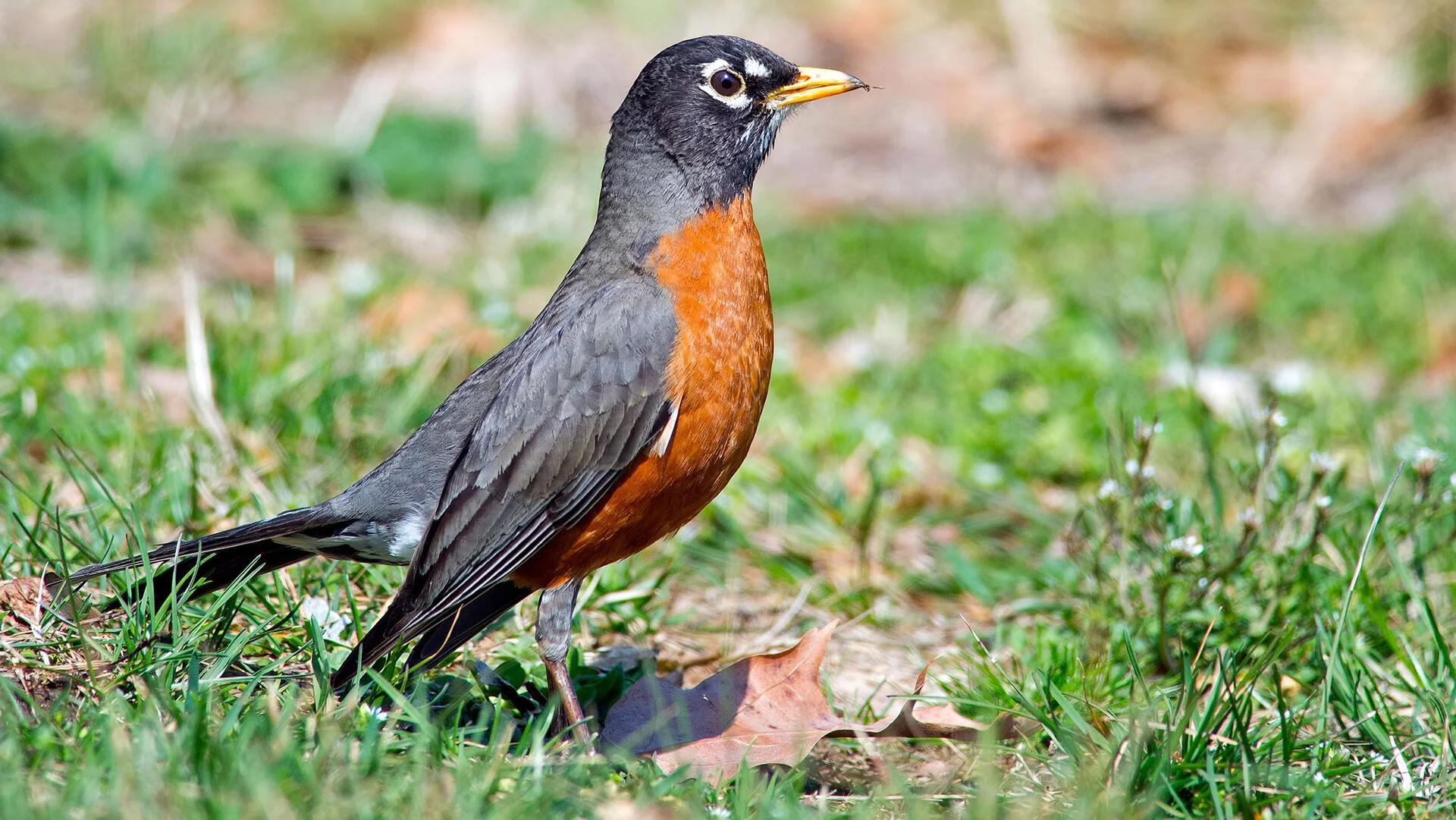
American Robins are a year-round sight in Georgia, although they are seen more often in the winter months. These birds feature in 28% of summer bird-watching records and 31% of winter records in the state.
Recognizable on lawns as they forage for earthworms, American Robins sport black heads and backs along with a red or orange breast. These birds typically roost in trees during winter and are more likely to frequent your backyard from spring onwards.
Scientific name: Turdus migratorius Size: Their length varies between 7.9-11.0 inches (20-28 cm), they weigh between 2.7-3.0 ounces (77-85 g), and their wingspan stretches from 12.2-15.8 inches (31-40 cm).
American Robins inhabit the lower 48 states, as well as the coast of western Canada and Alaska. Those that breed in Canada and inland Alaska tend to migrate south for the winter.
These birds adapt to a variety of habitats, ranging from forests and woodlands to mountains, fields, parks, and lawns. They feast on earthworms, insects, snails, and fruit.
To invite American Robins into your backyard, you can set up feeders with sunflower seeds, suet and peanut hearts, fruit, and mealworms. They prefer platform feeders or food scattered directly on the ground. Planting native berry-producing plants like juniper, sumac, hawthorn, and dogwood can also attract them.
7. Eastern Phoebe
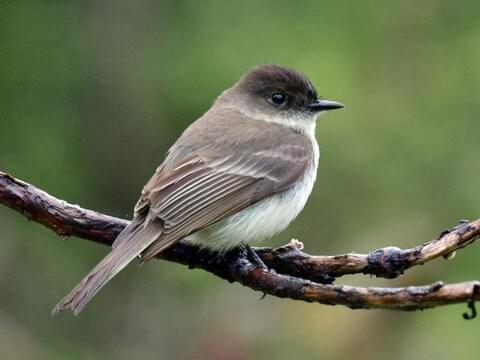
Eastern Phoebes are a common sight in Georgia throughout the year, with their presence increasing during the winter season. They’re included in 22% of summer bird-watching checklists and 26% of winter checklists.
These plump songbirds are characterized by their grayish-brown backs, lighter undersides, and comparatively darker heads.
Scientific name: Sayornis phoebe Size: They measure 5.5-6.7 inches (14-17 cm) in length, weigh between 0.6-0.7 ounces (16-21 g), and their wingspan ranges from 10.2-11.0 inches (26-28 cm).
Eastern Phoebes are migratory, breeding across the northeastern and central regions of the US and into Canada, and wintering in the southeastern US states and Mexico. A number of these birds might stay in the southernmost part of their range all year round.
Usually solitary, Eastern Phoebes are commonly found alone in quiet woodlands, often seen tail-wagging from low perches rather than in pairs or groups.
Belonging to the flycatcher family, their diet primarily consists of flying insects, but they also consume spiders, other insects, small fruits, and seeds. Their nests, built from mud and grass, are often spotted on bridges, barns, or residential structures.
To attract Eastern Phoebes to your backyard, consider installing a nest box or planting native berry-producing plants.
8. American Goldfinch – Female

American Goldfinches are sighted year-round in northern Georgia, and only during the winter in the southern part of the state. They are noted in 21% of bird-watching checklists for summer and 28% of winter checklists.
These attractive birds become particularly noticeable in spring when the males adorn vibrant yellow and black hues. Females and males during winter exhibit a more subdued brown coloration.
Scientific name: Spinus tristis Size: They measure between 4.3-5.1 inches (11-13 cm) in length, weigh from 0.4-0.7 ounces (11-20 g), and their wingspan spans 7.5-8.7 inches (19-22 cm).
American Goldfinches inhabit most of North America and usually stay in their habitat year-round. However, those breeding in Canada and the Midwest tend to migrate south to warmer US states for the winter.
These birds are often found foraging in weedy fields and overgrown patches where sunflower, thistle, and aster plants are available. They’re also frequent visitors of suburbs, parks, and backyard settings.
To attract American Goldfinches to your backyard, consider planting thistles and milkweed. These birds are known to frequent bird feeders, with a particular fondness for sunflower seeds and nyjer seeds.
9. Chipping Sparrow

Chipping Sparrows are a common sight in Georgia throughout the year, appearing on 23% of the bird-watchers’ checklists during the summer, and 25% during winter.
These slender, elongated birds have a grayish underbelly, and their back is streaked with black and brown. They are characterized by their rust-colored crowns and distinctive black lines around their eyes. However, these colors tend to be less prominent during the winter season.
Scientific name: Spizella passerina Size: Chipping Sparrows are typically 4.7-5.9 inches (12-15 cm) in length, weigh about 0.4-0.6 ounces (11-16 g), and have a wingspan of 8.3 inches (21 cm).
These birds breed in the US and Canada during the summer and then journey to Mexico and Florida for the winter season. However, some decide to stay in the southern states all year round.
Chipping Sparrows often gather in small flocks, foraging on open ground and are not shy to visit backyards in search of a variety of bird seeds.
To lure Chipping Sparrows to your backyard, try offering seeds or cracked corn on accessible feeders like hoppers or platforms.
10. Brown Thrasher

Brown Thrashers can be seen throughout the year in Georgia, with their presence being particularly notable from April to October. Bird watchers’ checklists show they are spotted in 28% of summer and 15% of winter observations.
Brown Thrashers are sizeable songbirds, approximately the size of a robin, with distinctive elongated bodies. Their backs are clad in brown feathers, while their chests and bellies are streaked white. These birds also have grey faces, highlighted by strikingly bright yellow eyes.
Scientific name: Toxostoma rufum Size: These birds measure between 9.1-11.8 inches (23-30 cm) in length, weigh about 2.1-3.1 ounces (61-89 g), and flaunt a wingspan of 11.4-12.6 inches (29-32 cm). Habitat: Brown Thrashers inhabit central and eastern North America. While those in the southeastern regions stay put year-round, their northern counterparts migrate south during the winter.
Despite their large size, Brown Thrashers can be challenging to spot as they typically dwell in thickets and dense shrubbery. Nevertheless, you can often hear them foraging in leaf litter and soil for insects. They also consume berries and beetles and can snatch flying insects mid-air.
These birds are recognized as remarkable songsters, capable of producing over 1000 different types of songs, one of the most extensive repertoires among North American songbirds.
To attract Brown Thrashers to your backyard, consider planting dense shrubs and berry-producing plants. They are also known to gather fallen seeds from underneath feeders.
11. Song Sparrow
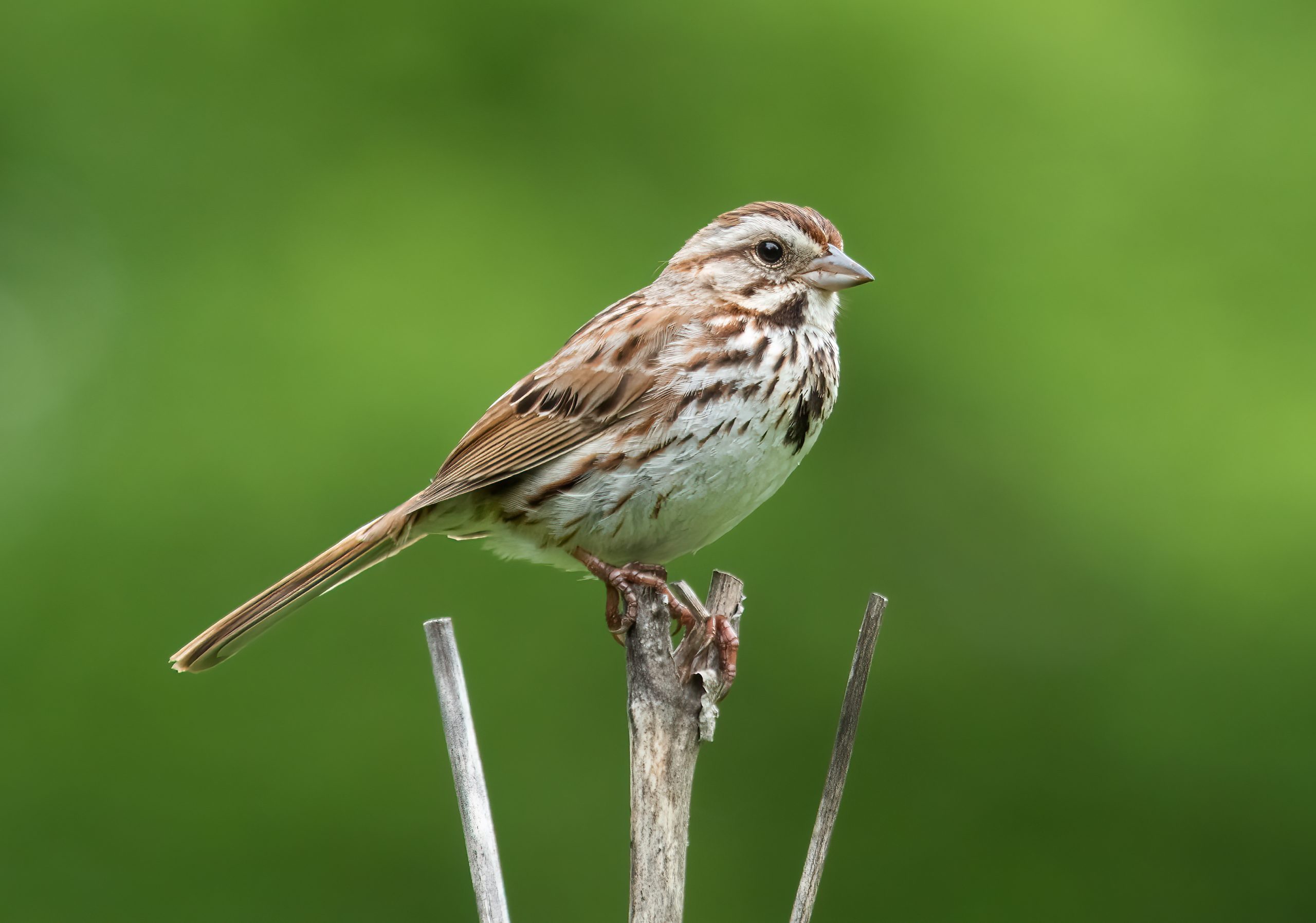
Song Sparrows are a common sight in Georgia, especially during the winter months, appearing in 25% of bird watchers’ checklists for this season. From November through March, these birds are particularly prominent, although some are seen throughout the year, especially along the coast, as indicated by their presence in 15% of summer checklists.
Despite their rather modest brown-streaked appearance compared to other backyard birds, Song Sparrows make their presence known through their near-constant melodious singing, primarily during spring and summer, to attract mates.
Scientific Name: Melospiza melodia Size: These birds measure between 4.7-6.7 inches (12-17 cm) in length, weigh between 0.4-1.9 ounces (12-53 g), and have a wingspan of 7.1-9.4 inches (18-24 cm).
Song Sparrows are year-round residents in the northern United States. However, those breeding in Canada tend to migrate south to the warmer climates of the southern US for the winter.
Typically found in open, wet, and shrubby areas, Song Sparrows often position themselves on low shrubs to sing their tunes. They’re also frequent visitors to backyard feeders.
Their diet is quite varied, consuming a broad mix of insects and plants. This includes beetles, caterpillars, midges, spiders, earthworms, and plant-based food like buckwheat, sunflower seeds, raspberries, wild cherries, blackberries, wheat, and rice.
To lure Song Sparrows to your backyard feeders, consider stocking them with black oil sunflower seeds, cracked corn, and nyjer seeds, ideally on platform feeders.
Georgia is home to a surprising number of sparrow species. Learning their unique songs and some interesting facts about them can make it easier and more enjoyable to identify these birds.
12. White-throated Sparrow
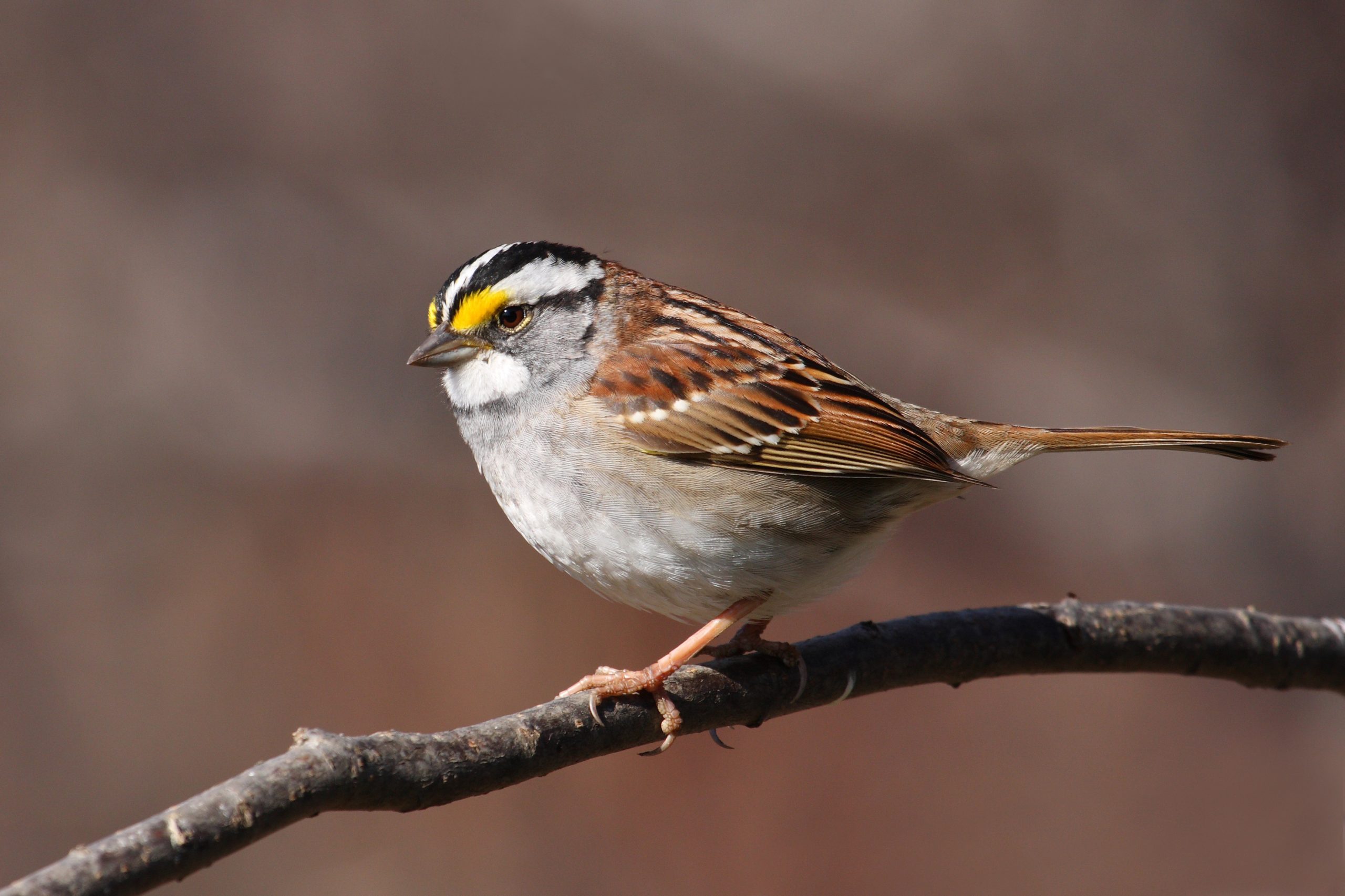
White-throated Sparrows are often seen in Georgia during the winter months, showing up in 21% of bird-watching checklists for this period. While a small number may be spotted throughout the year, their visibility peaks from October to mid-May.
Recognizable by their unique black and white striped heads, the White-throated Sparrows also feature a radiant white throat and a yellow patch between their eye and bill. The bird’s back is brown, while its underside sports a gray hue.
Scientific Name: Zonotrichia albicollis Size: These birds measure between 6.3-7.1 inches (16-18 cm) in length, weigh between 0.8-1.1 ounces (22-32 g), and have a wingspan ranging from 7.9 to 9.1 inches (20-23 cm).
White-throated Sparrows are migratory creatures, primarily breeding in Canada before flying south to the eastern and southern United States and along the Pacific Coast during winter.
Typically, White-throated Sparrows can be found foraging on the forest floor or along the fringes of woodlands, often moving in large groups.
Their diet is predominantly composed of grass and weed seeds and fruits like grapes, sumac, mountain ash, blueberries, blackberries, and dogwood. During the summer months, they also consume a variety of insects found on the forest floor.
You can draw White-throated Sparrows to your backyard by offering millet and black oil sunflower seeds on platform feeders.
13. Northern Flicker
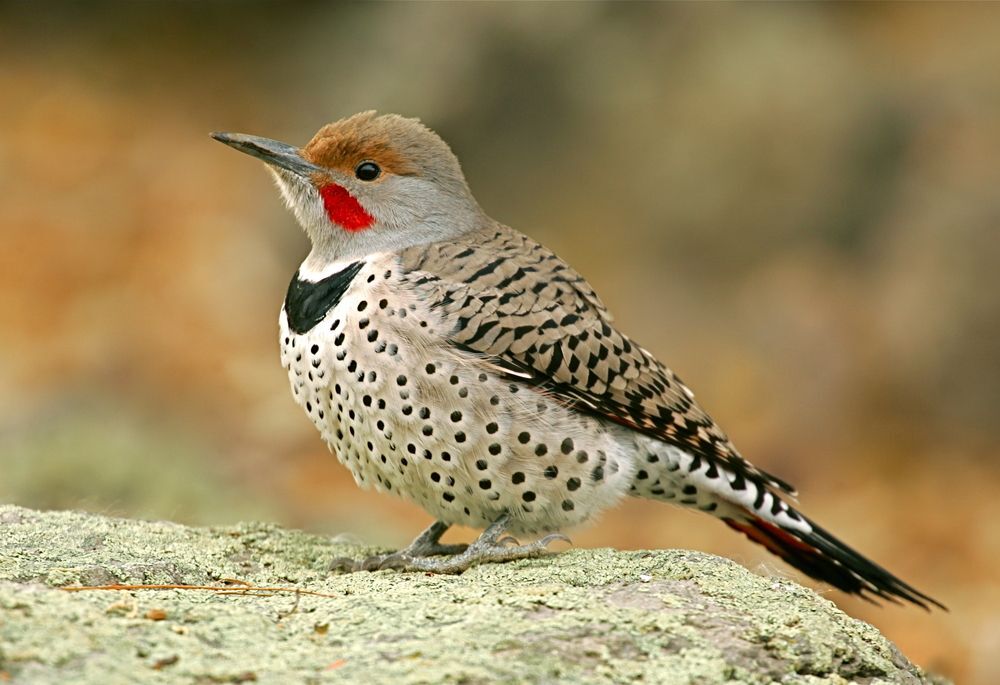
Northern Flickers are a constant presence in Georgia throughout the year, with sightings increasing during the winter months. They are noted in 5% of summer bird-watching checklists and 14% of winter lists.
Recognizable as large brown woodpeckers, Northern Flickers sport black spots and, while in flight, display a white patch on their rear. The males also bear a distinct red nape.
Depending on their origin, Northern Flickers exhibit either red or yellow flashes in their wings and tail. Red-shafted birds hail from the west, while yellow-shafted ones are found in the east.
Scientific Name: Colaptes auratus Size: These birds range in length from 11.0 to 12.2 inches (28-31 cm), weigh between 3.9 and 5.6 ounces (110-160 g), and boast a wingspan of 16.5 to 20.1 inches (42-51 cm).
Northern Flickers are sighted across the United States all year round and in Canada during the summer months. Those that breed in Canada migrate to the south for the winter.
Primarily feeding on ants and beetles, Northern Flickers also consume fruits and seeds. They can often be seen on the ground, using their curved bills to dig for food.
To attract Northern Flickers to your backyard, provide suet in your bird feeders. Additionally, other woodpecker species native to Georgia are also likely to visit your feeders.
14. Brown-headed Cowbird – Female

Brown-headed Cowbirds are year-round residents of Georgia, though they are most commonly sighted between March and July. They are recorded in 18% of summer birdwatching checklists and only 4% of winter lists.
The females of the species are uniformly brown with a hint of streaking across their bodies. Males, on the other hand, are larger and sport black bodies, brown heads, and relatively short tails.
Scientific Name: Molothrus ater Size: The bird measures between 7.6 and 8.7 inches (19-22 cm) in length, weighs around 1.3 to 1.8 ounces (42-50 g), and has a wingspan of approximately 14.2 inches (36 cm).
Brown-headed Cowbirds are perennial dwellers in the eastern, southern United States, and along the Pacific Coast. However, those that breed in the northern and western US states, and Canada, migrate to warmer climes in the winter.
Often perceived as a pest, Brown-headed Cowbirds have a notorious reputation due to their parasitic nature. They typically destroy the eggs of smaller songbirds, replacing them with their own, thereby tricking the host bird into raising their offspring.
15. Great-crested Flycatcher
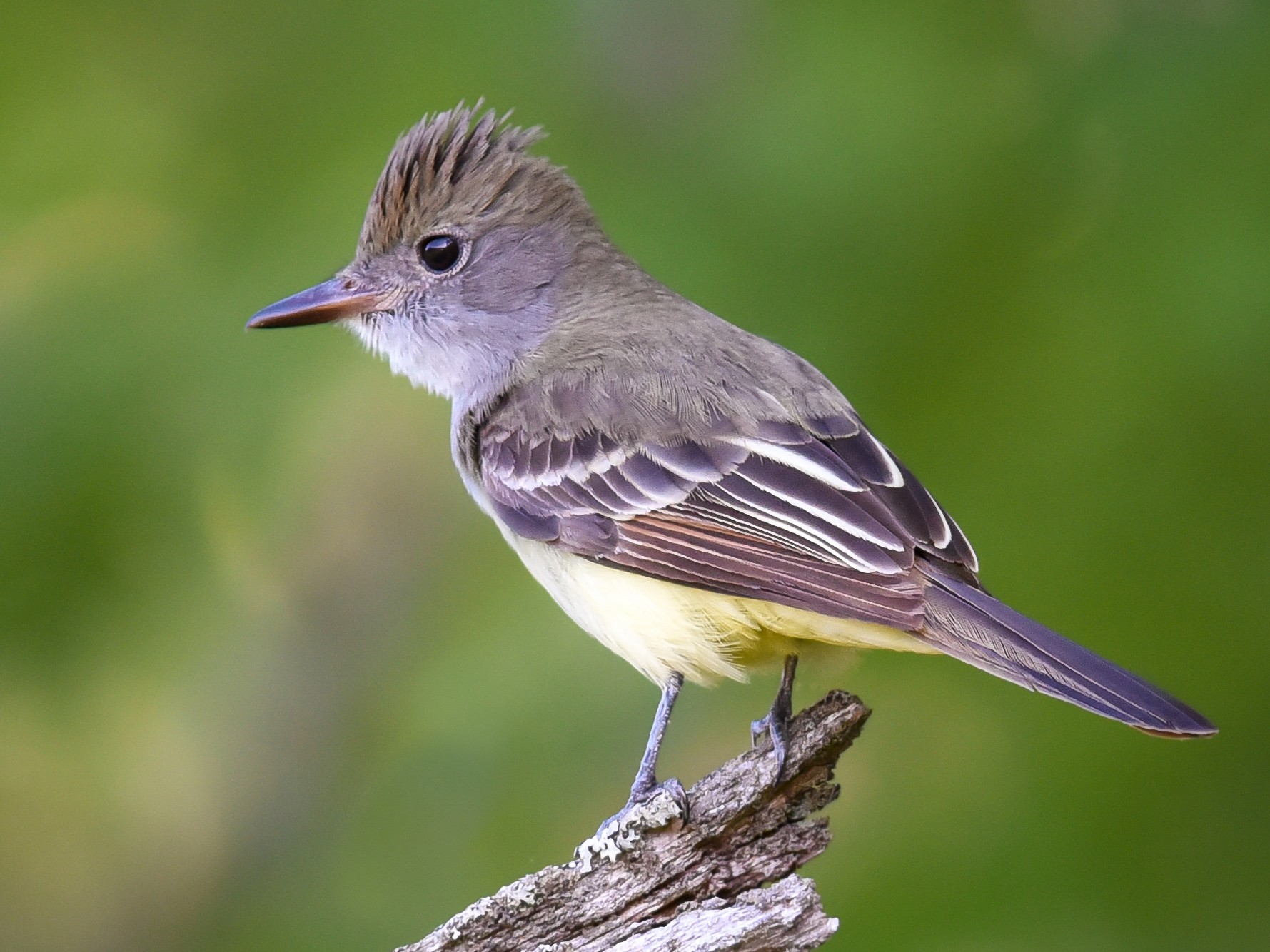
Great Crested Flycatchers reside in Georgia from March through October, their breeding season. They are noted in about 23% of summer bird sighting records.
The birds are identifiable by their brown backs and yellow bellies, offset by a grey throat. They exhibit reddish hues within their wing and tail feathers, though their titular crest is not particularly noticeable.
Scientific Name: Myiarchus crinitus Size: The bird measures between 6.7 and 8.3 inches (17-21 cm) in length, weighs approximately 0.9 to 1.4 ounces (27-40 g), and possesses a wingspan of around 13.4 inches (34 cm).
The Great Crested Flycatchers spend their breeding period over a significant portion of eastern North America, subsequently wintering in areas spanning southern Florida, southern Mexico, and Central America.
Favoring a lofty perch in woodlands, these birds lie in wait for large flying insects like butterflies, grasshoppers, moths, wasps, and spiders. They inhabit mixed woodlands, the fringes of open areas, parks, tree-laden neighborhoods, or artificial structures such as fence posts. They also consume berries and small fruits.
To encourage Great Crested Flycatchers to visit your backyard, consider planting native flora and maintaining brush piles to attract insects. Additionally, include berry-bearing plants and install a nest box, as these birds are inclined to occupy such shelters.
16. Common Yellowthroat

Common Yellowthroats are sighted throughout the year in southern Georgia, though they are particularly prevalent in the northern region during the mating season. In Georgia, they are documented in 12% of summer birdwatching records and 2% during winter.
These compact songbirds showcase a brownish hue on their backs with striking yellow undersides and possess lengthy tails. The males are distinguished by their black facial masks. The intensity of their yellow coloring may differ based on geographic location, and in some places, their undersides may appear more olive-toned.
Scientific Name: Geothlypis trichas Size: The bird measures between 4.3 and 5.1 inches (11-13 cm) in length, weighs around 0.3 ounces (9-10 g), and has a wingspan spanning 5.9 to 7.5 inches (15-19 cm).
Common Yellowthroats occupy the majority of North America for their breeding season, excluding Alaska and northern Canada. Some of them stay throughout the year in the Gulf Coast and the Pacific Southwest areas, migrating further south when winter arrives.
These birds are often found in marshlands, wetland areas, and brush-filled fields, preferring to live in dense, tangled vegetation.
To invite Common Yellowthroats into large, garden-like backyards, consider cultivating dense greenery and native plants that attract insects.
Common Yellowthroats are a category of warbler that can be found in Georgia, among numerous other species. They enchant with their captivating songs that are wonderful to listen to and learn.
17. Cedar Waxwing
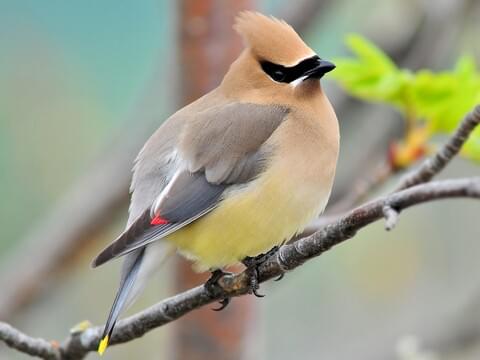
Cedar Waxwings are primarily observed in Georgia during the winter months, accounting for 9% of birdwatching records during this period. They can be sighted in the state from November through May, with some choosing to remain year-round in the northern region of the state.
Cedar Waxwings are graceful and sociable birds featuring a pale brown color on their head, chest, and crest, which transitions into gray on their back, wings, and tail. Their belly displays a light yellow hue that intensifies toward the tail. They exhibit a thin black mask over their eyes and vibrant red on their wingtips.
Scientific Name: Bombycilla cedrorum Size: These birds measure between 5.5 and 6.7 inches (14-17 cm) in length, weigh approximately 1.1 ounces (32 g), and have a wingspan ranging from 8.7 to 11.8 inches (22-30 cm).
Cedar Waxwings stay throughout the year in the northern part of the United States. Those breeding in Canada migrate to the southern half of the U.S. during the winter.
Cedar Waxwings produce a high-pitched call and are often found near berry bushes, woodlands, and streams.
To attract Cedar Waxwings to your backyard, consider planting native trees and shrubs that bear small fruits, such as serviceberry, dogwood, juniper, winterberry, and hawthorn. You can also try offering fruit on platform feeders.
18. House Sparrow
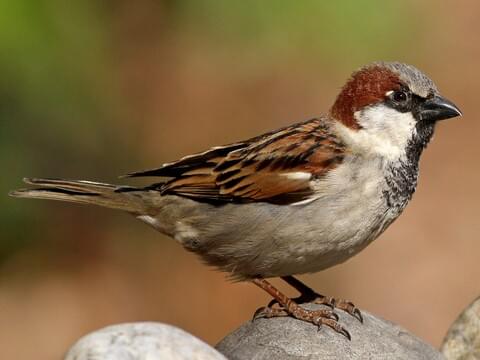
House Sparrows, an invasive species, can be seen throughout the year in Georgia. These birds do not migrate and are listed in about 6% of the state’s summer and winter bird watching checklists.
Having adapted extremely well since their introduction, House Sparrows have become one of the most prevalent bird species. They possess gray and brown heads and white cheeks. Their backs showcase black and brown shades, while their bellies are gray.
Scientific Name: Passer domesticus Size: They measure between 5.9 and 6.7 inches (15-17 cm) in length, weigh between 0.9 to 1.1 ounces (27-30 g), and have a wingspan of 7.5 to 9.8 inches (19-25 cm).
House Sparrows inhabit the US and southern Canada throughout the year. They are typically found in proximity to residential areas and structures. They are quite friendly, and some may even eat directly from your hand.
The diet of House Sparrows primarily includes grain and seeds, as well as discarded human food. While they can be seen as a nuisance due to their non-native status, they are often found in backyards even without any bird feed provided.
To attract House Sparrows to your backyard feeders, you can use a variety of birdseeds, including millet, corn, and sunflower seeds.
19. Field Sparrow

Field Sparrows can be observed throughout the year in Georgia, with their presence recorded in approximately 5% of both summer and winter bird watching lists.
These petite birds are easily identifiable with their slender brown backs, interspersed with black streaks. Their underparts and heads are gray, while they boast a striking reddish crown and a pinkish bill.
Scientific Name: Spizella pusilla Size: They measure between 4.7 and 5.9 inches (12-15 cm) in length, weigh between 0.4 to 0.5 ounces (11-15 g), and possess a wingspan of about 7.9 inches (20 cm).
Field Sparrows inhabit the eastern United States throughout the year, whereas those that breed in the Midwest migrate south for the winter.
During the breeding season, male Field Sparrows can be relatively easy to spot as they typically sing from a perch in the early morning hours. However, when not singing, they quietly feed on seeds and weeds and might be easily overlooked due to their preference for deserted fields and their timid nature.
Field Sparrows typically construct their nests on the ground for their first brood. As the breeding season progresses, subsequent nests are built progressively higher. Constructed from grass, the nests can house up to five eggs, which usually hatch within two weeks. The young ones then typically fledge after just a week.
To attract Field Sparrows to your backyard, consider providing cracked corn, hulled sunflower seeds, and millet.
20. Hermit Thrush
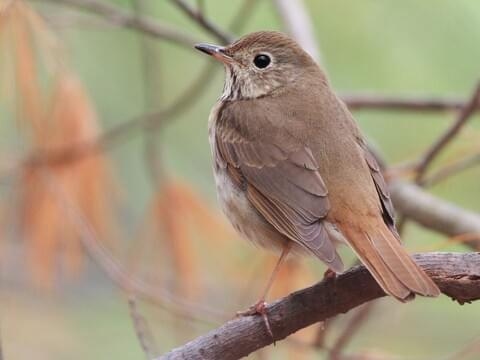
Hermit Thrushes are winter visitors in Georgia, appearing in 9% of birdwatching records during this period. They’re primarily observed from October through April.
These birds stand out due to their erect posture, stout bodies, and lengthy tails. Their upper bodies are brown, while their undersides are white, adorned with spots on their throats and chests.
Scientific Name: Catharus guttatus Dimensions: They measure between 5.5 to 7.1 inches (14-18 cm) in length, weigh from 0.8 to 1.3 ounces (23-37 g), and have a wingspan of approximately 9.8 to 11.4 inches (25-29 cm).
Hermit Thrushes breed in the northeastern and western parts of the US and throughout Canada. They pass through central states during migration, spending the winter in southeast states, along the Pacific Coast, and in Mexico.
These birds mainly forage on the ground in forest clearings, searching for insects in leaf litter. They supplement their diet with berries during winter.
While they seldom visit backyards, their melancholic song can often be heard during spring and summer.
21. Pine Siskin

Pine Siskins are predominantly winter visitors in Georgia, with the best chance to spot them between mid-October and May. They feature in 8% of winter birdwatching checklists in the state.
These birds are petite brown finches with yellow streaks gracing their wings and tails. They have forked tails, pointed wings, and short, sharp beaks.
Scientific Name: Spinus pinus Dimensions: Their length ranges from 4.3 to 5.5 inches (11-14 cm), they weigh between 0.4 and 0.6 ounces (12-18 g), and have a wingspan of about 7.1 to 8.7 inches (18-22 cm).
Pine Siskins inhabit pine forests in the western states and along the Canadian border throughout the year. Some even breed in Canada before migrating south for the winter season.
Their distribution across North America can vary depending on the availability of pine cone crops. True to their name, Pine Siskins primarily feed on seeds from coniferous trees, but they also consume young buds and seeds from grasses and weeds.
To draw Pine Siskins into your backyard, set up thistle and nyjer feeders. They’re also attracted to black oil sunflower seeds and suet.
22. House Wren
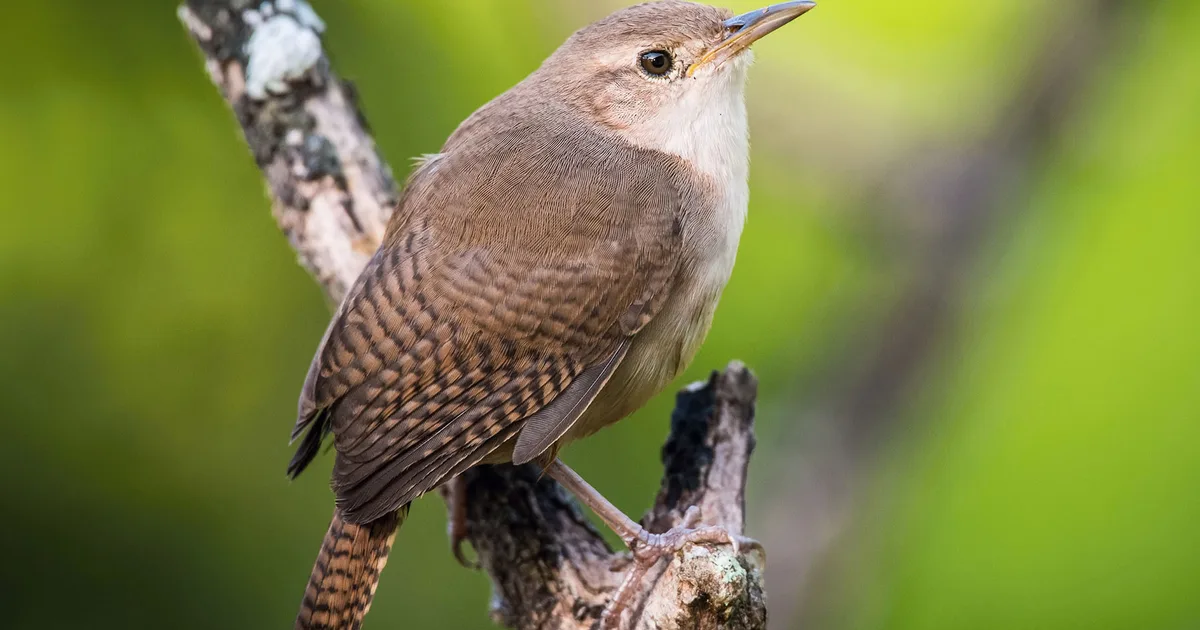
While House Wrens can be seen in Georgia throughout the year, they are more common during the spring and autumn migration periods. They feature in 5% of summer birdwatching checklists and 3% of those in winter.
House Wrens are petite, understated brown birds adorned with darker bars on their wings and tails and boasting a lighter throat. They are often observed with their tails standing upright.
Scientific Name: Troglodytes aedon Dimensions: They measure between 4.3 to 5.1 inches (11-13 cm) in length, weigh around 0.3 to 0.4 ounces (10-12 g), and have a wingspan of approximately 5.9 inches (15 cm).
House Wrens breed in the summer months across the US and southern Canada. Post-breeding, they migrate to the southern US and Mexico to winter.
These birds are typically found in backyards, parks, and open woods where they search for insects and spiders. Their behavior often involves vigorous hopping through bushes and lower branches, tails held high, punctuated by their joyous song.
Despite their small size, House Wrens show remarkable aggression when competing for prime nesting sites. They have been known to harass larger bird species, occasionally even expelling eggs or nestlings from a nest they desire.
To encourage House Wrens into your backyard, consider creating brush piles or installing a nest box.
23. Wood Thrush
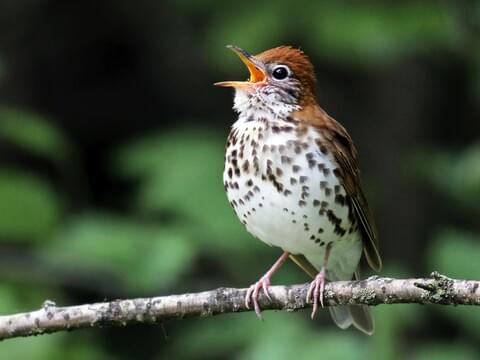
Wood Thrushes are primarily observed in Georgia during their breeding season, which spans from April to October, making appearances in about 11% of the birdwatching checklists during this period.
Wood Thrushes sport a whimsical look due to their round, white bellies speckled with black. Their backs are brown, and they have a reddish hue on their crowns and upper backs.
Scientific Name: Hylocichla mustelina Dimensions: They measure between 7.5 to 8.3 inches (19-21 cm) in length, weigh around 1.4 to 1.8 ounces (40-50 g), and their wingspan ranges from 11.8 to 13.4 inches (30-34 cm).
Wood Thrushes undergo their migration from the eastern regions of the United States across the Gulf of Mexico into Central America, accomplishing this journey in a single night.
These elusive creatures tend to stay concealed as they forage among leaf litter in mature forests for insects such as beetles and flies. In the spring, their characteristic ‘flute-like’ song can often be heard.
24. Swamp Sparrow
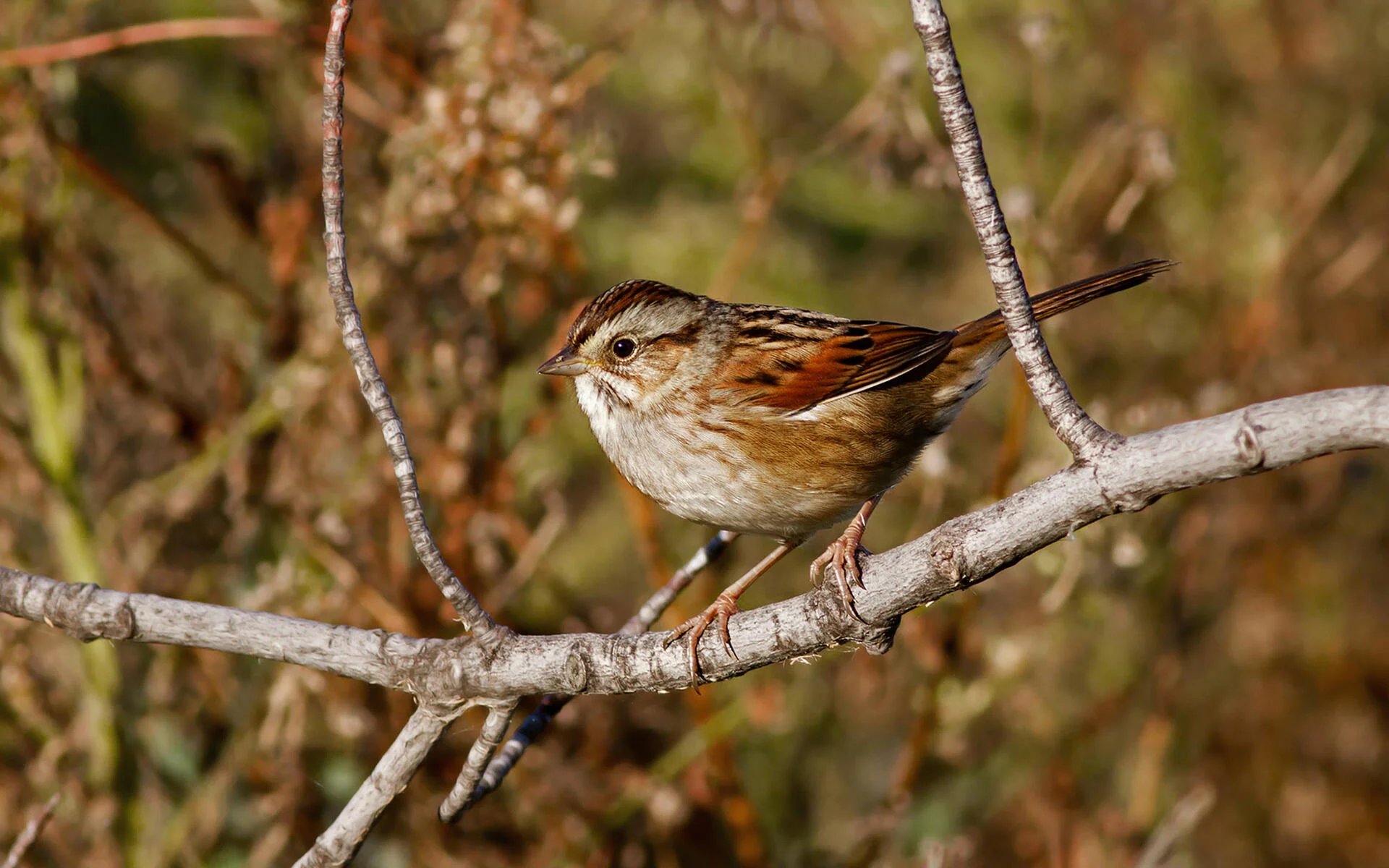
Swamp Sparrows are predominantly seen in Georgia during winter, commencing their arrival as early as September. Some of them stay till June, although the prime viewing period extends from October to April. They show up in approximately 6% of the state’s winter birdwatching checklists.
Sporting dark brown backs, Swamp Sparrows feature rustic crowns and wings. Their breasts are gray, contrasting with their white throats. Their faces are brown, featuring a gray head, a prominent dark line around their eyes, and a beak marked with a yellow tip.
Scientific Name: Melospiza georgiana Size: These birds range in length from 4.7 to 5.9 inches (12-15 cm), weigh between 0.5 and 0.8 ounces (15-23 g), and have a wingspan of approximately 7.1 to 7.5 inches (18-19 cm).
Swamp Sparrows predominantly inhabit the east, breeding in Canada, northeastern US, and north-central US states, subsequently migrating to eastern and southern US states, and Mexico.
True to their name, Swamp Sparrows thrive in wetland environments such as swamps, bogs, coastal marshes, and marshy areas, feeding mostly on seeds and fruits, particularly during winter. In spring, their diet includes more insects.
Swamp Sparrows typically build their nests, constructed of twigs, leaves, and cattails, hidden within vegetation either on or near the ground. These nests are lined with grass and various plant materials for comfort.
While they don’t often venture into backyards, Swamp Sparrows may pay visits during migration, especially to yards replete with vegetation and water.
25. Savannah Sparrow
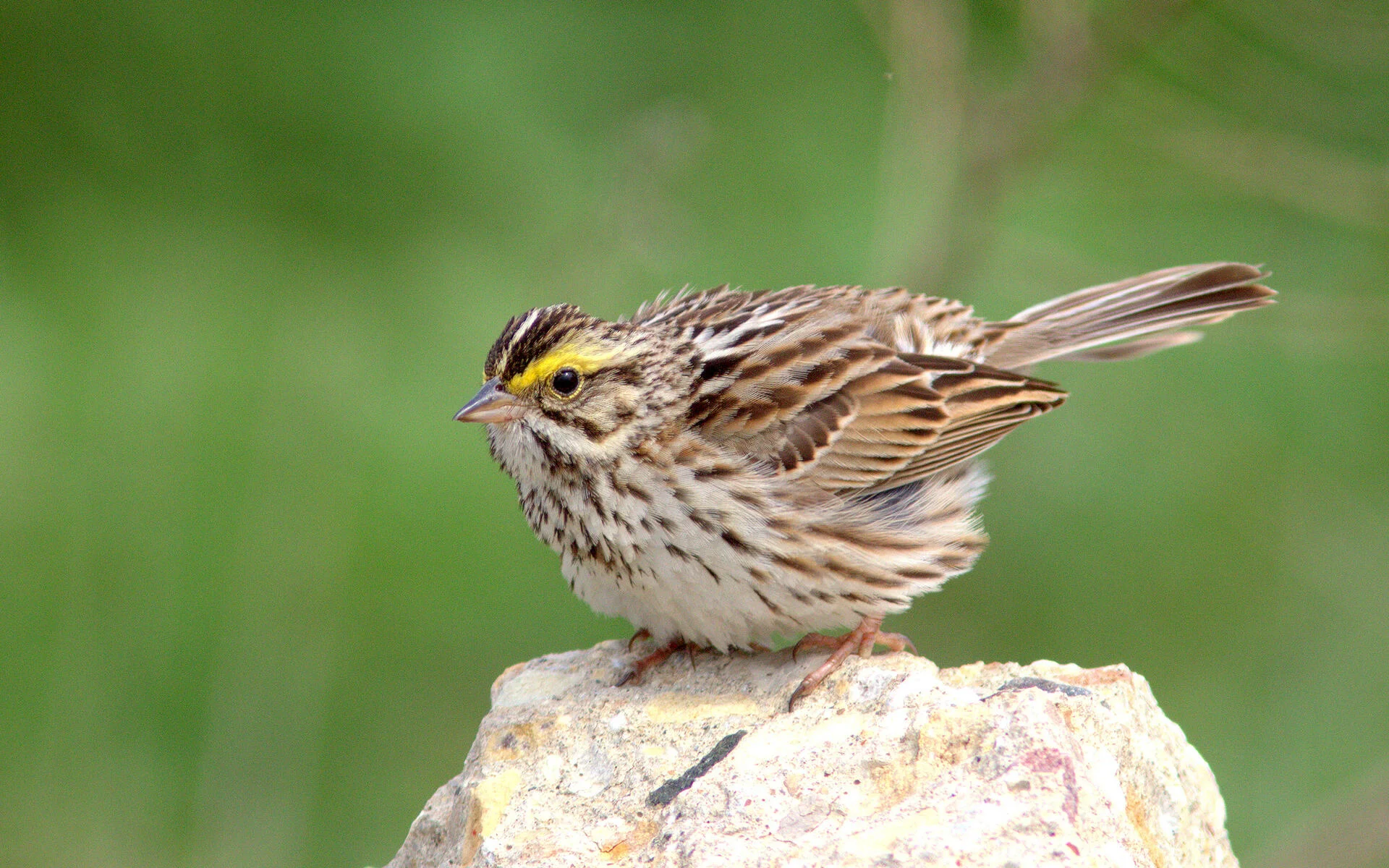
During the winter months, Savannah Sparrows choose to reside in Georgia, where they can be observed from September to May. They are present in approximately 5% of checklists conducted during the winter season.
A distinctive characteristic of the Savannah Sparrow is its brown plumage, complemented by a noticeable yellow patch near the eye. Additionally, they possess short tails and a streaky brown coloring.
Scientifically known as Passerculus sandwichensis, these birds measure around 4.3-5.9 inches (11-15 cm) in length, weigh between 0.5-1.0 ounces (15-28 g), and have a wingspan of 7.9-8.7 inches (20-22 cm).
Savannah Sparrows breed in Canada and the United States before embarking on their migration to southern states of the U.S. and Mexico for the winter season.
Typically found on the ground within open areas, such as grasslands, Savannah Sparrows primarily feed on insects and spiders during the breeding season, while shifting to a diet of seeds in the winter.
Their nests, constructed from grass, are situated either directly on the ground or in close proximity to it. Savannah Sparrows lay up to six eggs, which incubate for approximately two weeks, followed by an additional one or two weeks for the young to become independent and leave the nest.
Although these birds do not frequently visit bird feeders, they may be enticed to visit your yard if you provide brush piles, maintain long grass, and reside near fields.
26. Purple Finch – Female

During the winter months, from October to May, Purple Finches are commonly observed in Georgia and are present in approximately 5% of checklists conducted during this time.
Female Purple Finches display a brown-streaked appearance across their entire body, while males exhibit reddish-purple heads and breasts with more brown coloring on their back and wings, along with a paler belly. They bear a resemblance to House Finches, but their reddish hue, particularly at the upper part of their back, sets them apart.
Scientifically known as Haemorhous purpureus, these finches measure around 4.7-6.3 inches (12-16 cm) in length, weigh between 0.6-1.1 ounces (18-32 g), and have a wingspan of 8.7-10.2 inches (22-26 cm).
Purple Finches breed in Canada and migrate to the eastern states of the U.S. for the winter season, although they can be found year-round in the northeastern region and along the Pacific coast.
You can typically find Purple Finches in evergreen forests, where they primarily feed on seeds. However, they also consume buds, nectar, and berries.
The nests of Purple Finches are located at considerable heights within trees. They are constructed using twigs, barks, weeds, and moss. The female typically lays three to five eggs, which she incubates for a period of thirteen days.
To attract Purple Finches to your backyard, consider providing black oil sunflower seeds as a food source.
27. Rose-breasted Grosbeak – Female
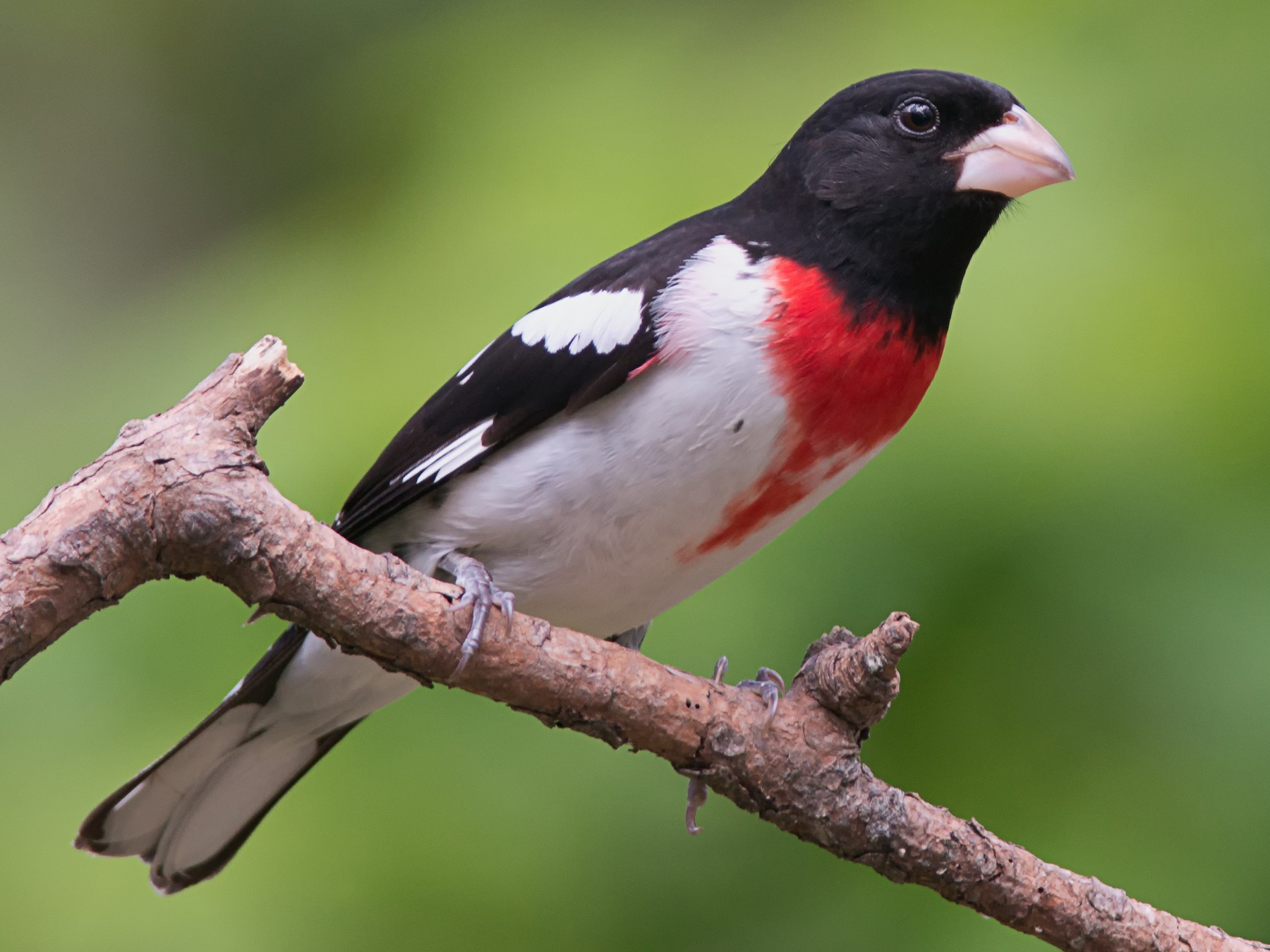
During migration, particularly from April to May and September to October, Rose-breasted Grosbeaks are commonly observed in Georgia. They are documented in approximately 16% of checklists during this migratory period.
Female Rose-breasted Grosbeaks and immature males possess a brown plumage with abundant streaking and a touch of yellow underneath their wings.
Male Rose-breasted Grosbeaks are striking black-and-white birds with black heads and backs, white bellies, and vibrant red breasts. They also exhibit a flash of red beneath their wings.
Scientifically known as Pheucticus ludovicianus, these grosbeaks measure around 7.1-8.3 inches (18-21 cm) in length, weigh between 1.4-1.7 ounces (39-49 g), and have a wingspan of 11.4-13.0 inches (29-33 cm).
Rose-breasted Grosbeaks breed in northeastern states of the U.S., the Midwest, and southern and central regions of Canada. During migration, they can be observed in southeastern states of the U.S. For the winter season, they migrate to Mexico, Central America, and the Caribbean.
You can typically find Rose-breasted Grosbeaks in forests, parks, and even backyards, where they forage for insects, berries, and seeds.
The nests of Rose-breasted Grosbeaks are situated within the branches of low trees. They are constructed using loosely-formed twigs, grass, and plants. A typical clutch consists of around five eggs, which hatch after a two-week incubation period. After hatching, both parents take turns incubating the eggs.
To attract Rose-breasted Grosbeaks to your backyard, consider providing sunflower seeds and peanuts as a food source.
28. Louisiana Waterthrush
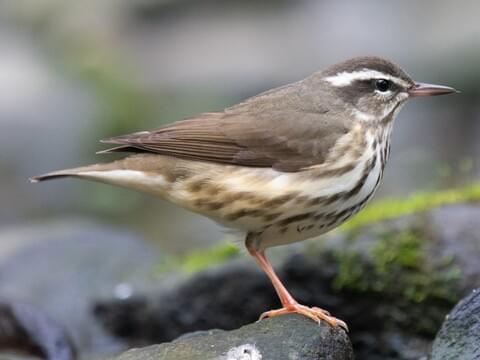
During the breeding season, which spans from February to September, Louisiana Waterthrushes are primarily observed in Georgia and are documented in around 3% of checklists conducted during the summer months.
Compared to other warblers, Louisiana Waterthrushes have a more subdued appearance. They exhibit a brown coloration on their upper body and a pale shade below. They are characterized by a white stripe above their eyes and sport long pink legs.
Scientifically known as Parkesia motacilla, these waterthrushes measure approximately 5.9-6.1 inches (15-15.5 cm) in length, weigh between 0.6-0.8 ounces (18.2-22.9 g), and have a wingspan of 9.4-10.6 inches (24-27 cm).
Louisiana Waterthrushes breed in eastern states of the U.S. and can be observed in the southeastern region during migration. They spend the winter months in Mexico, Central America, and the Caribbean, returning to their breeding grounds early in the spring.
You can typically find Louisiana Waterthrushes along streams and moving water in woodland areas, where they hunt for insects, vertebrates, and larvae.
The nests of Louisiana Waterthrushes are located along the banks of streams and are hidden in roots or under logs. Constructed using leaves, pine needles, and other plant materials, the nests are held together with mud.
29. Winter Wren

During the winter season, Winter Wrens can be found in Georgia and are recorded in approximately 3% of checklists. These tiny birds begin arriving as early as September and some may even stay until July, although the prime months to spot them are November through March.
Winter Wrens are small and plump, sporting a brown plumage with darker barring on their wings, tail, and belly. They possess a lighter eyebrow stripe and keep their short tails upright. Notably, there is no visual distinction between males and females.
They closely resemble Pacific Wrens and were once considered the same species. However, they are now recognized as distinct species with different songs.
Scientifically known as Troglodytes hiemalis, Winter Wrens are found in the eastern states of the U.S. during winter and in northeastern states of the U.S. and Canada during the summer.
To spot Winter Wrens, look for them hidden amidst tangled undergrowth in forests and even in backyard areas. They primarily feed on insects and spiders, foraging by rummaging through fallen leaves and decaying bark.
The nests of Winter Wrens are constructed using twigs, moss, and grass, skillfully woven together into a round shape with a small opening. They typically lay between 1 to 9 eggs, which hatch after a period of about two to two and a half weeks. The fledglings then require a similar duration to become independent.
To attract Winter Wrens to your backyard, consider cultivating native plants and creating dense vegetation, providing them with an inviting habitat.
30. Swainson’s Thrush
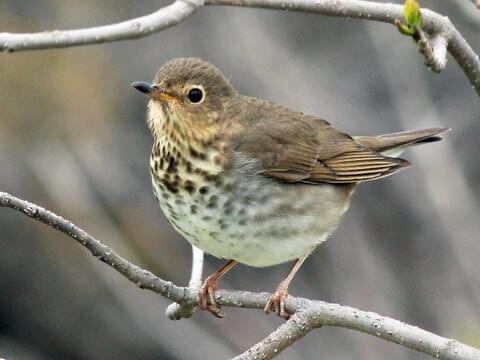
Swainson’s Thrushes are commonly observed in Georgia during migration, specifically from April to May and September to October. They are documented in around 5% of checklists during the spring and 13% during the fall.
These thrushes are medium-sized and display a pale underbody with spotted chests, while their back exhibits a brown coloration.
Scientifically known as Catharus ustulatus, Swainson’s Thrushes measure approximately 6.3-7.5 inches (16-19 cm) in length, weigh between 0.8-1.6 ounces (23-45 g), and have a wingspan of 11.4-12.2 inches (29-31 cm).
In the breeding season, Swainson’s Thrushes can be found in forests, where they forage along the forest floor amidst leaf litter, primarily feeding on insects. They also consume red fruits such as blackberries, raspberries, huckleberries, and sumac. Ants form part of their diet, and they feed other insects to their nestlings.
These thrushes are typically only seen during migration in the lower 48 states, as they breed in Canada and Alaska before embarking on their journey to Central and South America for the winter season.
To attract Swainson’s Thrushes to your backyard, consider providing ground-level birdbaths for water access and ensuring there is ample tree and shrub cover, creating a suitable habitat for them.
31. Marsh Wren
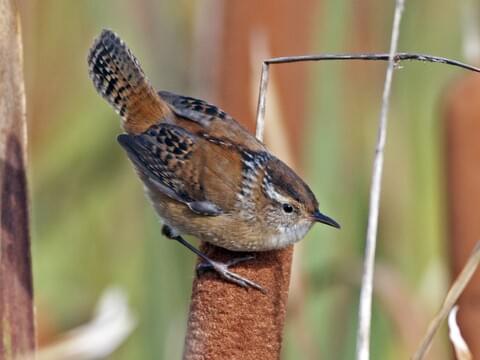
Marsh Wrens are commonly observed in Georgia, particularly during the spring and fall migration periods, although some individuals can be spotted throughout the year. They are recorded in around 1% of checklists during both summer and winter seasons.
These wrens display a brown coloration with black and white streaks on their back. Their underside is grayish brown, and they possess the characteristic upright tail of wrens. There is no visual distinction between males and females.
While Marsh Wrens bear similarities to other wren species, they can be differentiated by the absence of stripes on their shoulders and their longer bills compared to Sedge Wrens.
Scientifically known as Cistothorus palustris, Marsh Wrens breed in the northern states of the U.S. and Central Canada before embarking on migration to southern states and Mexico. Some individuals along the Atlantic Coast and in western regions may remain resident year-round. They can be observed during migration in the eastern parts of the U.S.
You can typically find Marsh Wrens in wetland areas, clinging to reeds, with each foot grasping a different stalk. They can be challenging to spot visually, but their distinctive singing among the reeds, particularly at dawn and dusk, can aid in locating them. Marsh Wrens primarily feed on insects and spiders, which they pluck from leaves close to the water.
The nests of Marsh Wrens are fully enclosed, except for a small opening at the top. They are constructed using reeds and grasses, intricately woven together.
32. Brown Creeper
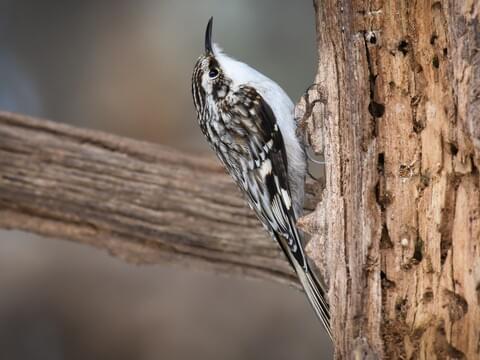
Brown Creepers are commonly observed in Georgia from October to March, although a few individuals may remain until June. They are recorded in approximately 1% of checklists during the winter season.
These tiny songbirds, known as Brown Creepers, possess streaked brown backs and white undersides, making them difficult to spot against tree trunks.
Scientifically known as Certhia americana, Brown Creepers do not undertake long-distance migration, but they may move southward or to lower elevations during the winter. They can be found in regions ranging from Alaska and southern Canada to the northeastern and eastern states of the U.S., extending down to Mexico and Central America. In certain winters, they also venture into central and southeastern states.
To catch sight of these small birds, carefully observe the tree trunks in mature woodlands with large trees, as this is where they can be found foraging for insects and larvae hidden within the bark.
One distinctive behavior of Brown Creepers is their habit of working their way up the tree trunks, facing upwards, unlike nuthatches that face downward.
Rather than singing, these songbirds emit a high-pitched, piercing call that aids in their detection and location.
33. Northern Waterthrush
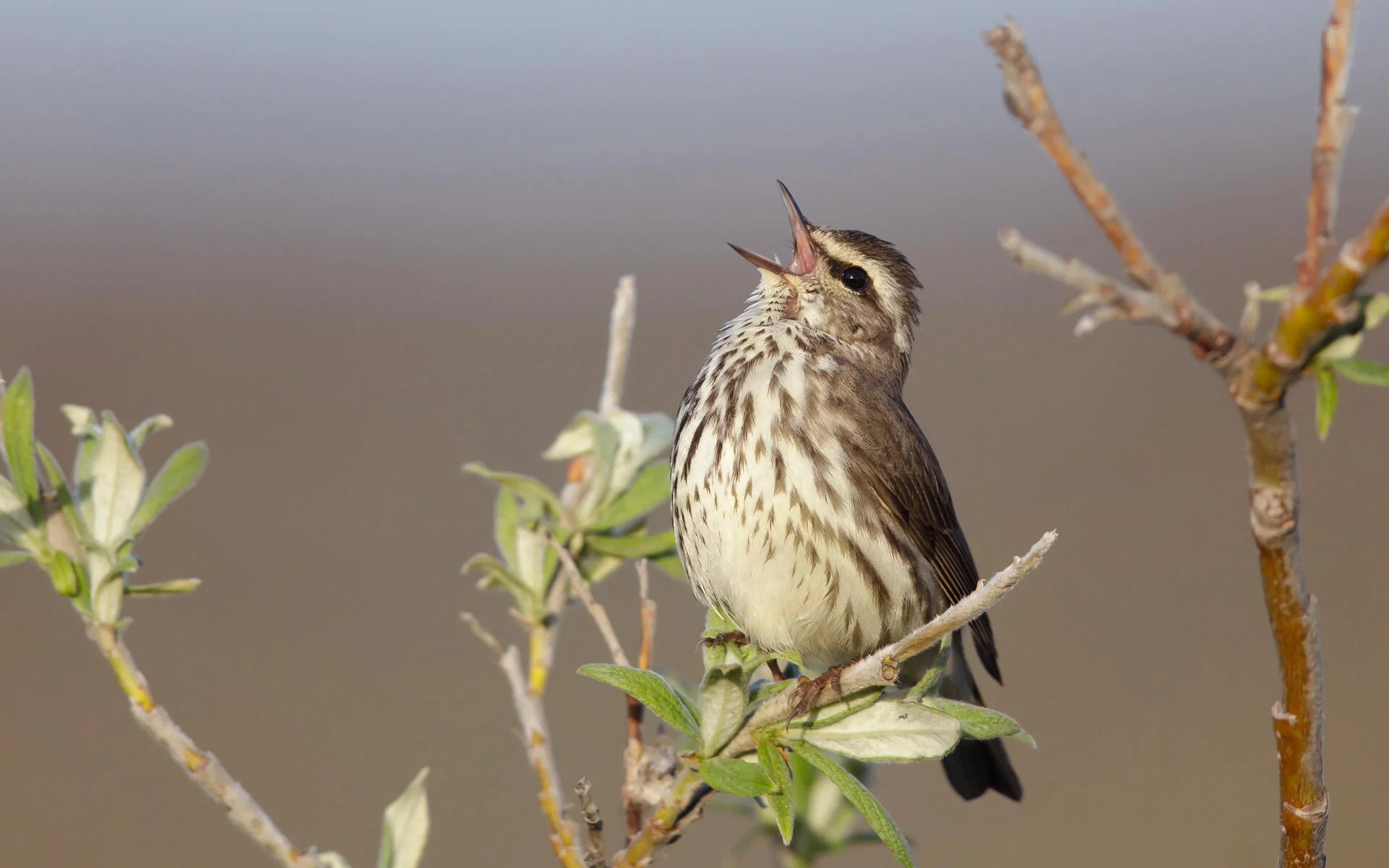
Northern Waterthrushes are commonly observed in Georgia during the winter season, but their presence increases during migration, particularly from April to May and August to October.
These birds, resembling thrushes in size and appearance, exhibit similar traits in both males and females. They have brown heads adorned with thick white eyebrows, dark brown backs, and white bellies with distinct, heavy streaking extending from their throats to their rumps.
Scientifically known as Parkesia noveboracensis, Northern Waterthrushes breed in Canada, Alaska, and northeastern states of the U.S. before embarking on their migration to Mexico, Central and South America, and the Caribbean. Some individuals may even remain year-round in Central and South America.
You can typically find Northern Waterthrushes in dark, woody swamps, thickets, and bogs. They are often associated with still or sluggish bodies of water within forested areas. During the winter season in tropical regions, they are commonly found among mangroves.
Northern Waterthrushes display both aquatic and terrestrial foraging behaviors. Their long legs enable them to walk on shallow water while searching for water beetles, mosquitoes, slugs, crustaceans, snails, and occasionally small fish. They also feed on caterpillars, moths, and ants, which they find beneath leaves.
The nests of Northern Waterthrushes are typically situated in hollows or crevices near water sources. They may be found in moss-covered stumps or beneath overhanging banks, but these nests are commonly concealed among ferns.
34. White-crowned Sparrow
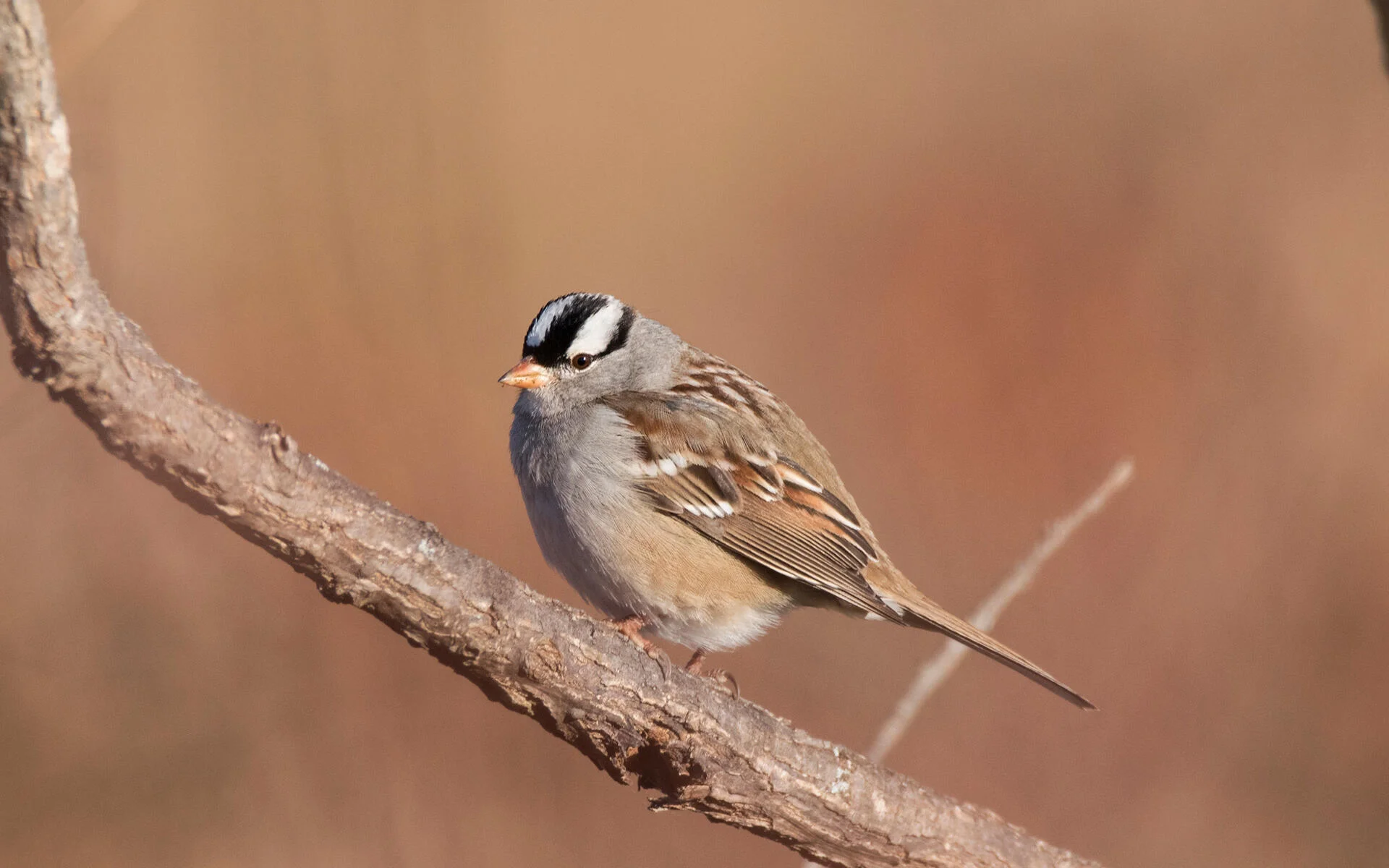
White-crowned Sparrows are not commonly found in Georgia, but during the winter season, they can be spotted in the state. Their presence spans from late September to mid-May, with the optimal months for sighting being October through April.
These sparrows, characterized by their large size, exhibit a grayish plumage with long tails, small bills, and distinctive black and white stripes adorning their heads.
Scientifically known as Zonotrichia leucophrys, White-crowned Sparrows breed in Alaska and arctic regions of Canada before embarking on their journey southward to the lower 48 states and Mexico for the winter season. However, some individuals may choose to remain along the Pacific Coast and in mountainous areas throughout the year.
You can typically find White-crowned Sparrows in weedy fields, alongside roadsides, forest edges, and even in yards, where they forage for seeds of weeds and grasses. They also consume fruits such as elderberries and blackberries.
The nests of White-crowned Sparrows are constructed using twigs, grass, moss, and pine needles. They are often positioned low to the ground in shrubs or even on the ground in tundra regions. The female lays up to seven eggs, which hatch after a two-week incubation period. The chicks then take around nine days to fledge and become independent.
To attract White-crowned Sparrows to your backyard, consider providing sunflower seeds as a food source. They may also feed on seeds dropped by other birds at the feeders.
35. American Tree Sparrow

American Tree Sparrows are considered rare or accidental species in Georgia, with sightings reported around Altamaha Wildlife Management Area in 2021.
These sparrows exhibit a distinct appearance, characterized by their long tails, brown-streaked plumage, rusty caps, gray faces, and a rusty eye line.
Scientifically known as Spizelloides arborea, American Tree Sparrows are birds of the winter season in the United States and the summer season in Canada. They breed in the northern regions of Canada and Alaska, then migrate to various states in the U.S. for the winter, excluding the Pacific and Gulf Coasts.
You can typically find American Tree Sparrows foraging in small flocks within weedy fields and beneath bird feeders.
The nests of American Tree Sparrows are usually located on or near the ground, constructed using twigs, grass, and moss. They lay approximately five eggs, which hatch in just under two weeks, and the young birds fledge in a little over a week.
To attract American Tree Sparrows to your backyard, consider using platform feeders and offering black oil sunflower seeds, nyjer, cracked corn, and millet. They also feed on seeds that have fallen to the ground from tube feeders.
36. Spotted Towhee

Spotted Towhees are considered accidental species in Georgia, making their sightings extremely rare in the state. There have been no recent reports of their presence.
These towhees are large sparrows, exhibiting distinct differences between males and females. Males showcase a black head, throat, and back, while females have a brown coloration. Both genders feature reddish-brown sides, white bellies, long tails, and white spots on their wings and back.
Scientifically known as Pipilo maculatus, Spotted Towhees primarily inhabit western states of the U.S. However, those located inland in the northern regions migrate southward to Texas after breeding.
Spotted Towhees can typically be found on the ground within dense tangles of shrubs, actively scratching around for insects such as beetles, crickets, grasshoppers, caterpillars, wasps, and bees. They also feed on acorns, berries, and seeds.
The nests of Spotted Towhees are typically positioned on or near the ground, constructed using leaves, stems, bark, and lined with softer materials. They lay a clutch of up to six eggs, which hatch after a two-week incubation period, and the young birds fledge within approximately ten days.
To attract Spotted Towhees to your yard, consider maintaining overgrown borders, as they are attracted to such habitats. They may visit platform feeders or ground feeders if provided with Black Oil Sunflower seeds, Hulled Sunflower seeds, Cracked Corn, Millet, and Milo as food sources.
37. Bewick’s Wren
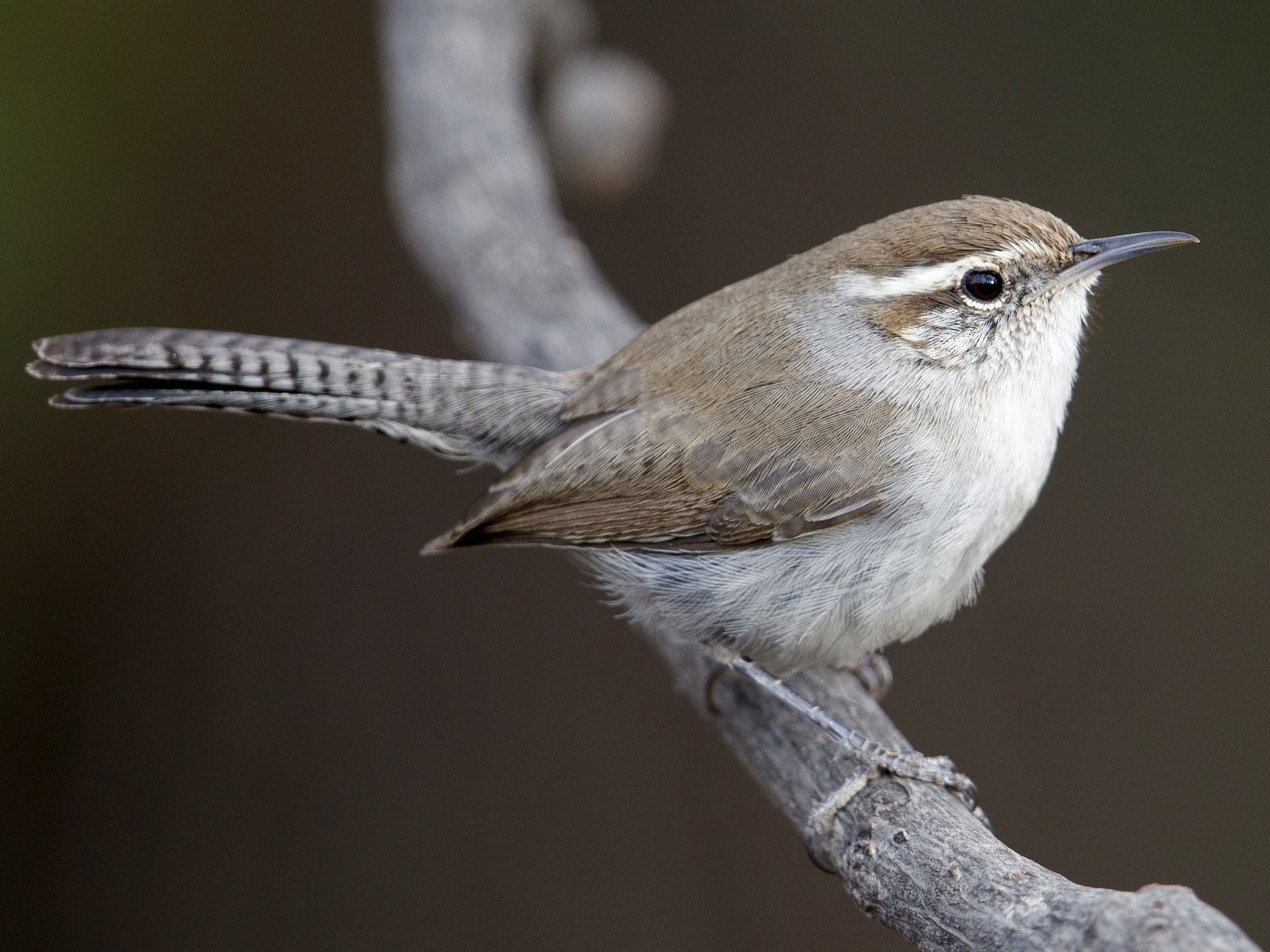
Bewick’s Wrens are exceptionally rare in Georgia and are considered accidental species within the state. There have been no recent sightings reported.
These wrens display brown backs, long gray upright tails with darker barring, gray bellies, and a distinctive white stripe above the eye.
Scientifically known as Thryomanes bewickii, Bewick’s Wrens are year-round residents of southern and western states, with minor movements observed during the winter season.
You can typically find Bewick’s Wrens in scrub areas, thickets, and open woodlands, as they hop from branch to branch, flicking their long tails. They primarily feed on insects and larvae, including bees, bugs, caterpillars, and beetles.
Nests are often found on rock ledges, old woodpecker nests, nest boxes, or crevices within buildings. They possess a cup-shaped structure constructed from sticks and grasses, with a softer lining. Bewick’s Wrens lay a clutch of 3 to 8 eggs, which hatch after a two-week incubation period. The fledging process takes an additional two weeks.
To attract Bewick’s Wrens to your backyard, consider providing suet, mealworms, and hulled sunflower seeds as food sources.
How Frequently Brown Birds Are Spotted In Georgia In Summer And Winter
Checklists serve as valuable references for identifying the commonly observed bird species within a particular state. These lists provide insights into the prevalent brown-colored birds frequently recorded on checklists during the summer and winter seasons in Georgia, as compiled and documented on eBird.
